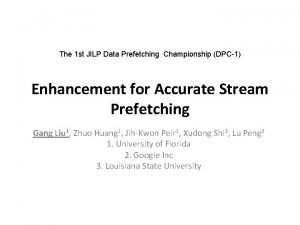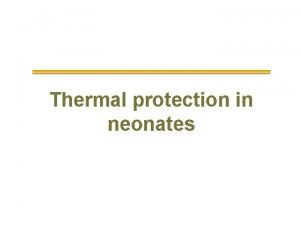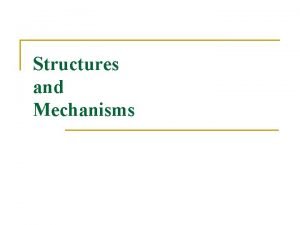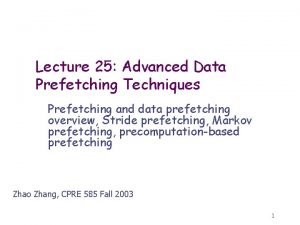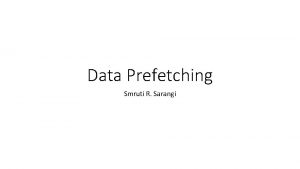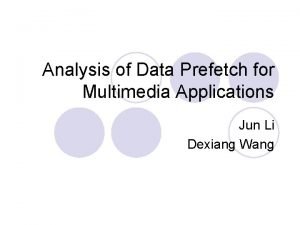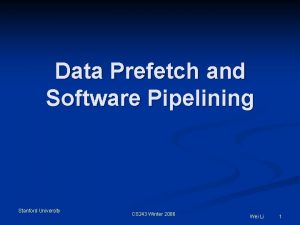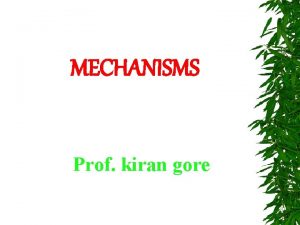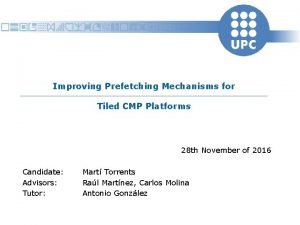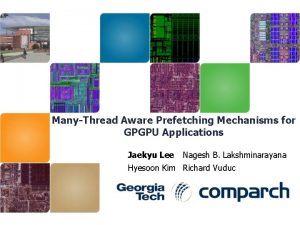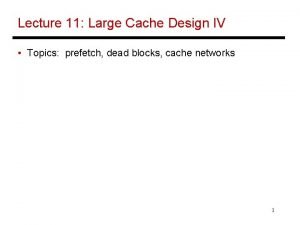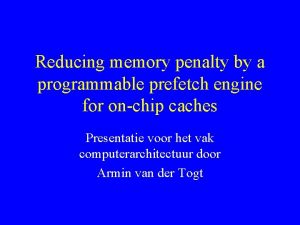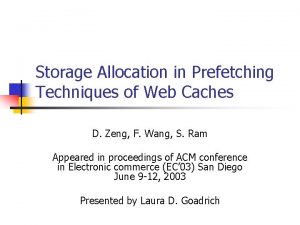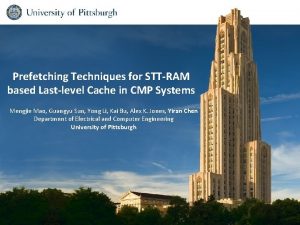Prefetching Techniques Reading n Data prefetch mechanisms Steven























![Example float a[100], b[100], c[100]; . . . for (i = 0; i < Example float a[100], b[100], c[100]; . . . for (i = 0; i <](https://slidetodoc.com/presentation_image_h/926ec0eff907e821cbc8d25f32eb9b83/image-24.jpg)

- Slides: 25

Prefetching Techniques

Reading n Data prefetch mechanisms, Steven P. Vanderwiel, David J. Lilja, ACM Computing Surveys, Vol. 32 , Issue 2 (June 2000) 2

Prefetching Predict future cache misses n Issue a fetch to memory system in advance of the actual memory reference n Hide memory access latency n 3

Examples r 1 r 2 r 3 4

Basic Questions 1. When to initiate prefetches? n Timely n n 2. Where to place prefetched data? n 3. Too early replace other useful data (cache pollution) or be replaced before being used Too late cannot hide processor stall Cache or dedicated buffer What to be prefetched? 5

Prefetching Approaches n Software-based ¨ Explicit “fetch” instructions ¨ Additional instructions executed n Hardware-based ¨ Special hardware ¨ Unnecessary prefetchings (w/o compiletime information) 6

Side Effects and Requirements n Side effects ¨ Prematurely prefetched blocks possible “cache pollution” ¨ Removing processor stall cycles (increase memory request frequency); unnecessary prefetchings higher demand on memory bandwidth n Requirements ¨ Timely ¨ Useful ¨ Low overhead 7

Software Data Prefetching n “fetch” instruction ¨ Non-blocking memory operation ¨ Cannot cause exceptions (e. g. page faults) n n Modest hardware complexity Challenge -- prefetch scheduling ¨ Placement of fetch inst relative to the matching load or store inst ¨ Hand-coded by programmer or automated by compiler 8

Loop-based Prefetching n Loops of large array calculations ¨ Common in scientific codes ¨ Poor cache utilization ¨ Predictable array referencing patterns n fetch instructions can be placed inside loop bodies s. t. current iteration prefetches data for a future iteration 9

Example: Vector Product n No prefetching for (i = 0; i < N; i++) { sum += a[i]*b[i]; } n Assume each cache block holds 4 elements 2 misses/4 iterations n Simple prefetching for (i = 0; i < N; i++) { fetch (&a[i+1]); fetch (&b[i+1]); sum += a[i]*b[i]; } n Problem ¨ Unnecessary prefetch operations, e. g. a[1], a[2], a[3] 10

Example: Vector Product (Cont. ) n Prefetching + loop unrolling for (i = 0; i < N; i+=4) { fetch (&a[i+4]); fetch (&b[i+4]); sum += a[i]*b[i]; sum += a[i+1]*b[i+1]; sum += a[i+2]*b[i+2]; sum += a[i+3]*b[i+3]; } n Problem ¨ First and last iterations n Prefetching + software pipelining fetch (&sum); fetch (&a[0]); fetch (&b[0]); for (i = 0; i < N-4; i+=4) { fetch (&a[i+4]); fetch (&b[i+4]); sum += a[i]*b[i]; sum += a[i+1]*b[i+1]; sum += a[i+2]*b[i+2]; sum += a[i+3]*b[i+3]; } for (i = N-4; i < N; i++) sum = sum + a[i]*b[i]; 11

Example: Vector Product (Cont. ) n n n Previous assumption: prefetching 1 iteration ahead is sufficient to hide the memory latency When loops contain small computational bodies, it may be necessary to initiate prefetches d iterations before the data is referenced d: prefetch distance, l: avg memory latency, s is the estimated cycle time of the shortest possible execution path through one loop iteration fetch (&sum); for (i = 0; i < 12; i += 4){ fetch (&a[i]); fetch (&b[i]); } for (i = 0; i < N-12; i += 4){ fetch(&a[i+12]); fetch(&b[i+12]); sum = sum + a[i] *b[i]; sum = sum + a[i+1]*b[i+1]; sum = sum + a[i+2]*b[i+2]; sum = sum + a[i+3]*b[i+3]; } for (i = N-12; i < N; i++) sum = sum + a[i]*b[i]; 12

Limitation of Software-based Prefetching Normally restricted to loops with array accesses n Hard for general applications with irregular access patterns n Processor execution overhead n Significant code expansion n Performed statically n 13

Hardware Inst. and Data Prefetching n No need for programmer or compiler intervention No changes to existing executables Take advantage of run-time information n E. g. , Instruction Prefetching n n ¨ ¨ ¨ n Alpha 21064 fetches 2 blocks on a miss Extra block placed in “stream buffer” On miss check stream buffer Works with data blocks too: Jouppi [1990] 1 data stream buffer got 25% misses from 4 KB cache; 4 streams got 43% ¨ Palacharla & Kessler [1994] for scientific programs for 8 streams got 50% to 70% of misses from 2 64 KB, 4 -way set associative caches ¨ n Prefetching relies on having extra memory bandwidth that can be used without penalty 14

Sequential Prefetching n n Take advantage of spatial locality One block lookahead (OBL) approach ¨ Initiate a prefetch for block b+1 when block b is accessed ¨ Prefetch-on-miss n Whenever an access for block b results in a cache miss ¨ Tagged prefetch n Associates a tag bit with every memory block n When a block is demand-fetched or a prefetched block is referenced for the first time. 15

OBL Approaches n Prefetch-on-miss demand-fetched prefetched n Tagged prefetch 0 1 1 1 demand-fetched prefetched 16

Degree of Prefetching n OBL may not initiate prefetch far enough to avoid processor memory stall Prefetch K > 1 subsequent blocks n Adaptive sequential prefetching n ¨ Additional traffic and cache pollution ¨ Vary the value of K during program execution ¨ High spatial locality large K value ¨ Prefetch efficiency metric ¨ Periodically calculated ¨ Ratio of useful prefetches to total prefetches 17

Stream Buffer K prefetched blocks FIFO stream buffer n As each buffer entry is referenced n ¨ Move it to cache ¨ Prefetch a new block to stream buffer n Avoid cache pollution 18

Stream Buffer Diagram from processor to processor Tags head tail tag and comp tag tag Direct mapped cache Data a a one one cache block +1 next level of cache of of data Stream buffer Source: Jouppi ICS’ 90 Shown with a single stream buffer (way); multiple ways and filter may 19 be used

Prefetching with Arbitrary Strides Employ special logic to monitor the processor’s address referencing pattern n Detect constant stride array references originating from looping structures n Compare successive addresses used by load or store instructions n 20

Basic Idea n n Assume a memory instruction, mi, references addresses a 1, a 2 and a 3 during three successive loop iterations Prefetching for mi will be initiated if D: assumed stride of a series of array accesses The first prefetch address (prediction for a 3) A 3 = a 2 + D Prefetching continues in this way until 21

Reference Prediction Table (RPT) n Hold information for the most recently used memory instructions to predict their access pattern ¨ Address of the memory instruction ¨ Previous address accessed by the instruction ¨ Stride value ¨ State field 22

Organization of RPT PC effective address instruction tag previous address stride state + prefetch address 23
![Example float a100 b100 c100 for i 0 i Example float a[100], b[100], c[100]; . . . for (i = 0; i <](https://slidetodoc.com/presentation_image_h/926ec0eff907e821cbc8d25f32eb9b83/image-24.jpg)
Example float a[100], b[100], c[100]; . . . for (i = 0; i < 100; i++) for (j = 0; j < 100; j++) for (k = 0; k < 100; k++) a[i][j] += b[i][k] * c[k][j]; instruction tag ld b[i][k] ld c[k][j] ld a[i][j] previous address 50000 50004 50008 90000 90400 90800 10000 stride 0 400 800 0 state initial steady trans initial steady 24

Software vs. Hardware Prefetching n Software ¨ Compile-time analysis, schedule fetch instructions within user program n Hardware ¨ Run-time n analysis w/o any compiler or user support Integration ¨ e. g. compiler calculates degree of prefetching (K) for a particular reference stream and pass it on to the prefetch hardware. 25
 Perceptron-based prefetch filtering
Perceptron-based prefetch filtering Prefeching
Prefeching Prefetching relevant priors
Prefetching relevant priors Pre reading while reading and post reading activities
Pre reading while reading and post reading activities Les fonctions techniques et les solutions techniques
Les fonctions techniques et les solutions techniques Scan text
Scan text What is skiming
What is skiming Kinds of reading skills
Kinds of reading skills Ineffictive
Ineffictive A poem a.skimming b.scanning c.extensive d.intensive
A poem a.skimming b.scanning c.extensive d.intensive Round robin reading vs popcorn reading
Round robin reading vs popcorn reading Reading aims
Reading aims Definition of guided reading
Definition of guided reading It is an active process of discovery.
It is an active process of discovery. Real definition of extensive reading
Real definition of extensive reading Intensive reading and extensive reading
Intensive reading and extensive reading Mechanisms of movement lab report
Mechanisms of movement lab report Tools and mechanisms of virtualization in cloud computing
Tools and mechanisms of virtualization in cloud computing Behaviorist theory of personality
Behaviorist theory of personality Homeostasis mechanisms for regulation of body temperature
Homeostasis mechanisms for regulation of body temperature Evaporation heat loss newborn
Evaporation heat loss newborn Ego defense mechanisms
Ego defense mechanisms What are the first line of defense
What are the first line of defense Behaviorist theory of personality
Behaviorist theory of personality Mechanism and structure
Mechanism and structure How do sponges protect themselves
How do sponges protect themselves

